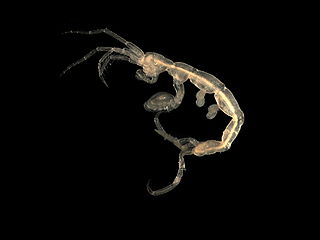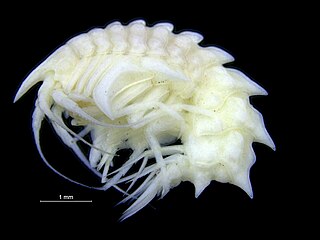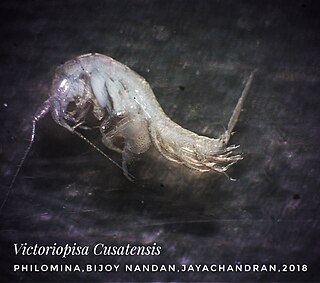James Kenneth Lowry (1942 [1] [2] - 2021) [3] was a zoologist specialising in amphipods. [4] [5] [6]
He was born in Kansas City, Missouri, and grew up near Chesapeake Bay. [7] This led to a B.A in biology from the University of Richmond followed by an M.A in marine science from the College of William and Mary, where he worked on the benthic fauna of the Antarctic island, Anvers Island. [7] His interest in Antarctic benthic fauna led to his Ph. D. from the University of Canterbury (New Zealand) [7] in 1976 with the thesis, Studies on the macrobenthos of the Southern Ocean, [8] researching which, he spent two winters at the New Zealand base on Ross Island near McMurdo Station, [7] and during which time he survived five days on Antarctic sea ice, with three fellow students, after a late-evening sail went wrong. [9]
He retired as a principal research scientist at the Australian Museum, where he worked from 1976 [3] to 2011.
His zoological author abbreviation is Lowry. [10]

Amphipoda is an order of malacostracan crustaceans with no carapace and generally with laterally compressed bodies. Amphipods range in size from 1 to 340 millimetres and are mostly detritivores or scavengers. There are more than 9,900 amphipod species so far described. They are mostly marine animals, but are found in almost all aquatic environments. Some 1,900 species live in fresh water, and the order also includes the terrestrial sandhoppers such as Talitrus saltator and Arcitalitrus sylvaticus.

Gammaridea is one of the suborders of the order Amphipoda, comprising small, shrimp-like crustaceans. Until recently, in a traditional classification, it encompassed about 7,275 (92%) of the 7,900 species of amphipods described by then, in approximately 1,000 genera, divided among around 125 families. That concept of Gammaridea included almost all freshwater amphipods, while most of the members still were marine.
Hadziidae is a family of amphipods, which is difficult to distinguish from the related family Melitidae. It contains the following genera:

Corophiida is an infraorder of amphipods that contains the two parvorders Caprellidira and Corophiidira.

Epimeriidae is a family of relatively large amphipods found in cold oceans around the world.
Melphidippidae is a family of amphipods which rest upside-down and feed on particles of food suspended in the water. Three genera are recognised:
Paracalliopiidae is a family of amphipods, containing the following genera:

Caprelloidea is a superfamily of marine crustaceans in the order Amphipoda. It includes "untypical" forms of amphipods, such as the skeleton shrimps (Caprellidae) and whale lice (Cyamidae). The group was formerly treated as one of the four amphipod suborders, Caprellidea, but has been moved down to the superfamily rank by Myers & Lowry after phylogenetic studies of the group, and is now contained in the infraorder Corophiida of the suborder Senticaudata. The group includes the following families.

Senticaudata is one of the four suborders of the crustacean order Amphipoda. It includes some 5000 species, which is more than 50% or the currently recognized amphipod diversity.
Cochinorchestia is a genus of amphipod belonging to the family Talitridae.

Victoriopisa cusatensis is a amphipod species in the family Eriopisidae. The species name ‘cusatensis’ refers to the Cochin University of Science and Technology (CUSAT). This species has been described by the team of researchers in 2018 from the Valanthakad mangrove area of Vembanad backwater.

Eurythenes plasticus is a species of amphipod of the genus Eurythenes, first described in 2020. It was named in reference to the PET plastic found in its stomach, after researchers wanted to highlight the impact of plastic pollution.
Iphigenellidae is a freshwater family of amphipods in the superfamily Gammaroidea. It is found in the Ponto-Caspian region, which encompasses the Black, Azov, and Caspian Seas.
Glossocephalus milneedwardsi is a species of amphipod in the family Oxycephalidae. It is epipelagic and lives in association with ctenophores.

Cystisoma is a genus of amphipod. It is the only member of the family Cystisomatidae within the Hyperiidea. The genus is noted for its nearly completely transparent body, adapted for life in low light waters.
Guilherme Muricy is a Brazilian invertebrate zoologist, and Professor of Invertebrate Zoology at the National Museum of Brazil. He is a specialist in sponges and has written over 100 papers on the chemistry, the taxonomy of sponges, and the descriptions of many new sponge species.

Maeridae is a family of marine amphipods, which was first described by Taudl Krapp-Schickel in 2008.
Elasmopus arrawarra is a marine species of amphipod in the family, Maeridae, and was first described in 2006 by Lauren E. Hughes and James K. Lowry.
Lauren Elizabeth Hughes is an Australian carcinologist and curator. She specialises in the study of amphipods.
Aborolobatea insidiosa is a species of marine crustacean in the Oedicerotidae family, and was first described in 2009 by Lauren E. Hughes and James K. Lowry.